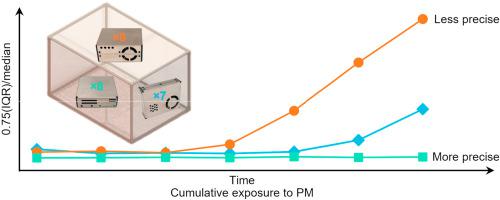当前位置:
X-MOL 学术
›
J. Aerosol Sci.
›
论文详情
Our official English website, www.x-mol.net, welcomes your feedback! (Note: you will need to create a separate account there.)
Effects of aerosol type and simulated aging on performance of low-cost PM sensors
Journal of Aerosol Science ( IF 4.5 ) Pub Date : 2020-12-01 , DOI: 10.1016/j.jaerosci.2020.105654 Jessica Tryner , John Mehaffy , Daniel Miller-Lionberg , John Volckens
Journal of Aerosol Science ( IF 4.5 ) Pub Date : 2020-12-01 , DOI: 10.1016/j.jaerosci.2020.105654 Jessica Tryner , John Mehaffy , Daniel Miller-Lionberg , John Volckens

|
Abstract Studies that characterize the performance of low-cost particulate matter (PM) sensors are needed to help practitioners understand the accuracy and precision of the mass and number concentrations reported by different models. We evaluated Plantower PMS5003, Sensirion SPS30, and Amphenol SM-UART-04L PM sensors in the laboratory by exposing them to: (1) four different polydisperse aerosols (ammonium sulfate, Arizona road dust, NIST Urban PM, and wood smoke) at concentrations ranging from 10 to 1000 μg m−3, (2) hygroscopic and hydrophobic aerosols (ammonium sulfate and oil) in an environment with varying relative humidity (15%–90%), (3) polystyrene latex spheres (PSL) ranging from 0.1 to 2.0 μm in diameter, and (4) extremely high concentrations of Arizona road dust (18-h mean total PM = 33,000 μg m−3; 18-h mean PM2.5 = 7300 μg m−3). Linear models relating PMS5003- and SPS30-reported PM2.5 concentrations to TEOM-reported ammonium sulfate concentrations up to 1025 μg m−3, nebulized Arizona road dust concentrations up to 540 μg m−3, and NIST Urban PM concentrations up to 330 μg m−3 had R2 ≥ 0.97; however, an F-test identified a significant lack of fit between the model and the data for each sensor/aerosol combination. Ratios of filter-derived to PMS5003-reported PM2.5 concentrations were 1.4, 1.7, 1.0, 0.4, and 4.3 for ammonium sulfate, nebulized Arizona road dust, NIST Urban PM, wood smoke, and oil mist, respectively. For SPS30 sensors, these ratios were 1.6, 2.1, 2.1, 0.6, and 2.2, respectively. Collocated PMS5003 sensors were less precise than collocated SPS30 sensors when measuring ammonium sulfate, nebulized Arizona road dust, NIST Urban PM, oil mist, or PSL. Our results indicated that particle count data reported by the PMS5003 were not reliable. The number size distribution reported by the PMS5003 (a) did not agree with APS data and (b) remained roughly constant whether the sensors were exposed to 0.1 μm PSL, 0.27 μm PSL, 0.72 μm PSL, 2.0 μm PSL, or any of the other laboratory-generated aerosols. The size distribution reported by the SPS30 did not always agree with APS data, but did shift towards larger particle sizes when the sensors were exposed to 0.72 PSL, 2.0 μm PSL, oil mist, or Arizona road dust from a fluidized bed generator. The proportions of PM mass assigned as PM1, PM2.5, and PM10 by all three sensor models shifted as the PSL size increased. After the sensors were exposed to high concentrations of Arizona road dust for 18 h, PM2.5 concentrations reported by SPS30 sensors remained consistent, whereas 3/8 PMS5003 sensors and 2/7 SM-UART-04L sensors began reporting erroneously high values.
中文翻译:

气溶胶类型和模拟老化对低成本 PM 传感器性能的影响
摘要 需要研究表征低成本颗粒物 (PM) 传感器的性能,以帮助从业人员了解不同模型报告的质量和数量浓度的准确性和精度。我们在实验室中评估了 Plantower PMS5003、Sensirion SPS30 和 Amphenol SM-UART-04L PM 传感器,方法是将它们暴露于以下浓度:(1) 四种不同的多分散气溶胶(硫酸铵、亚利桑那州道路灰尘、NIST 城市 PM 和木材烟雾)范围从 10 到 1000 μg m−3,(2) 具有不同相对湿度 (15%–90%) 的环境中的吸湿性和疏水性气溶胶(硫酸铵和油),(3) 范围从 0.1 的聚苯乙烯乳胶球 (PSL)到 2.0 μm 的直径,以及 (4) 极高浓度的亚利桑那州道路灰尘(18 小时平均总 PM = 33,000 μg m-3;18 小时平均 PM2.5 = 7300 μg m-3)。将 PMS5003 和 SPS30 报告的 PM2.5 浓度与 TEOM 报告的硫酸铵浓度高达 1025 μg m-3、雾化亚利桑那州道路灰尘浓度高达 540 μg m-3 和 NIST 城市 PM 浓度高达 330 μg 相关联的线性模型m−3 的 R2 ≥ 0.97;然而,F 检验发现模型与每个传感器/气溶胶组合的数据之间明显缺乏拟合。对于硫酸铵、雾化亚利桑那州道路灰尘、NIST 城市 PM、木烟和油雾,过滤器衍生的 PM2.5 浓度与 PMS5003 报告的 PM2.5 浓度的比率分别为 1.4、1.7、1.0、0.4 和 4.3。对于 SPS30 传感器,这些比率分别为 1.6、2.1、2.1、0.6 和 2.2。在测量硫酸铵、雾化的亚利桑那州道路灰尘、NIST Urban PM、油雾或 PSL 时,配置的 PMS5003 传感器不如配置的 SPS30 传感器精确。我们的结果表明 PMS5003 报告的粒子计数数据不可靠。PMS5003 报告的数字大小分布 (a) 与 APS 数据不一致,(b) 无论传感器暴露于 0.1 μm PSL、0.27 μm PSL、0.72 μm PSL、2.0 μm PSL 或任何一种其他实验室产生的气溶胶。SPS30 报告的粒径分布并不总是与 APS 数据一致,但当传感器暴露于 0.72 PSL、2.0 μm PSL、油雾或来自流化床发生器的亚利桑那州道路灰尘时,确实会转向更大的粒径。所有三个传感器模型指定为 PM1、PM2.5 和 PM10 的 PM 质量比例随着 PSL 尺寸的增加而变化。在传感器暴露于高浓度的亚利桑那州道路灰尘 18 小时后,PM2.
更新日期:2020-12-01
中文翻译:

气溶胶类型和模拟老化对低成本 PM 传感器性能的影响
摘要 需要研究表征低成本颗粒物 (PM) 传感器的性能,以帮助从业人员了解不同模型报告的质量和数量浓度的准确性和精度。我们在实验室中评估了 Plantower PMS5003、Sensirion SPS30 和 Amphenol SM-UART-04L PM 传感器,方法是将它们暴露于以下浓度:(1) 四种不同的多分散气溶胶(硫酸铵、亚利桑那州道路灰尘、NIST 城市 PM 和木材烟雾)范围从 10 到 1000 μg m−3,(2) 具有不同相对湿度 (15%–90%) 的环境中的吸湿性和疏水性气溶胶(硫酸铵和油),(3) 范围从 0.1 的聚苯乙烯乳胶球 (PSL)到 2.0 μm 的直径,以及 (4) 极高浓度的亚利桑那州道路灰尘(18 小时平均总 PM = 33,000 μg m-3;18 小时平均 PM2.5 = 7300 μg m-3)。将 PMS5003 和 SPS30 报告的 PM2.5 浓度与 TEOM 报告的硫酸铵浓度高达 1025 μg m-3、雾化亚利桑那州道路灰尘浓度高达 540 μg m-3 和 NIST 城市 PM 浓度高达 330 μg 相关联的线性模型m−3 的 R2 ≥ 0.97;然而,F 检验发现模型与每个传感器/气溶胶组合的数据之间明显缺乏拟合。对于硫酸铵、雾化亚利桑那州道路灰尘、NIST 城市 PM、木烟和油雾,过滤器衍生的 PM2.5 浓度与 PMS5003 报告的 PM2.5 浓度的比率分别为 1.4、1.7、1.0、0.4 和 4.3。对于 SPS30 传感器,这些比率分别为 1.6、2.1、2.1、0.6 和 2.2。在测量硫酸铵、雾化的亚利桑那州道路灰尘、NIST Urban PM、油雾或 PSL 时,配置的 PMS5003 传感器不如配置的 SPS30 传感器精确。我们的结果表明 PMS5003 报告的粒子计数数据不可靠。PMS5003 报告的数字大小分布 (a) 与 APS 数据不一致,(b) 无论传感器暴露于 0.1 μm PSL、0.27 μm PSL、0.72 μm PSL、2.0 μm PSL 或任何一种其他实验室产生的气溶胶。SPS30 报告的粒径分布并不总是与 APS 数据一致,但当传感器暴露于 0.72 PSL、2.0 μm PSL、油雾或来自流化床发生器的亚利桑那州道路灰尘时,确实会转向更大的粒径。所有三个传感器模型指定为 PM1、PM2.5 和 PM10 的 PM 质量比例随着 PSL 尺寸的增加而变化。在传感器暴露于高浓度的亚利桑那州道路灰尘 18 小时后,PM2.


























 京公网安备 11010802027423号
京公网安备 11010802027423号